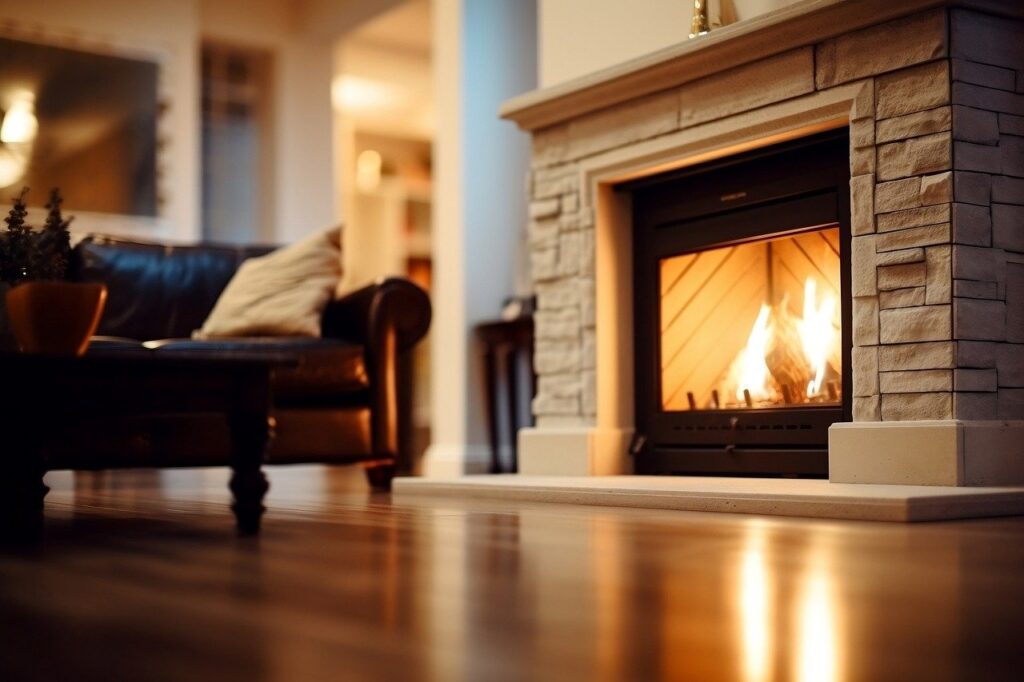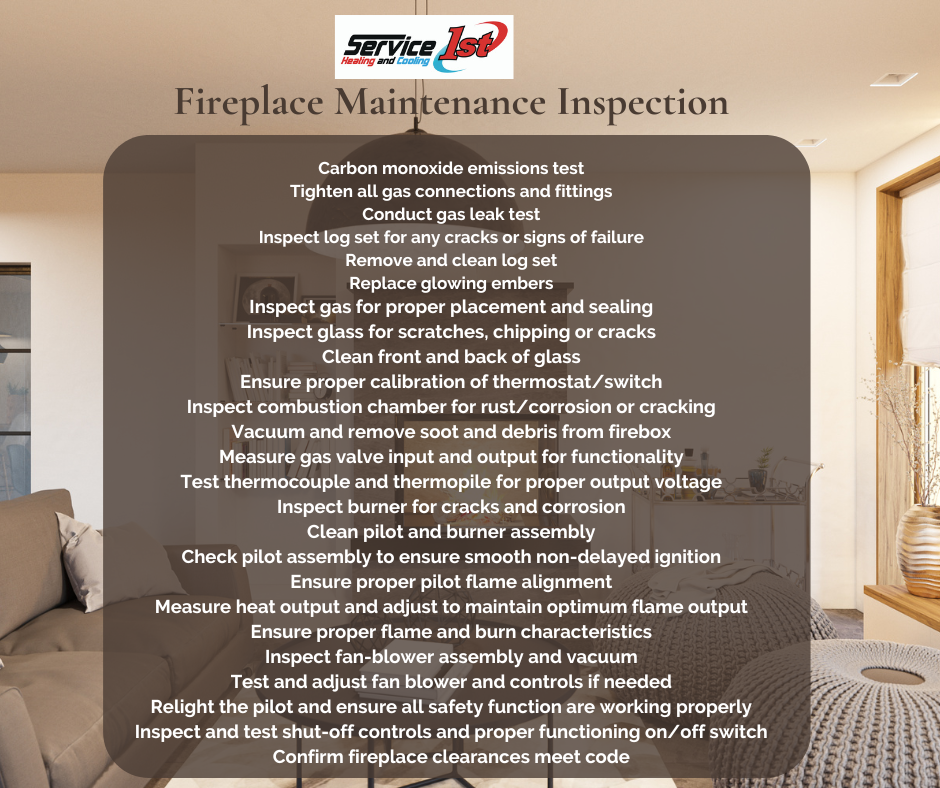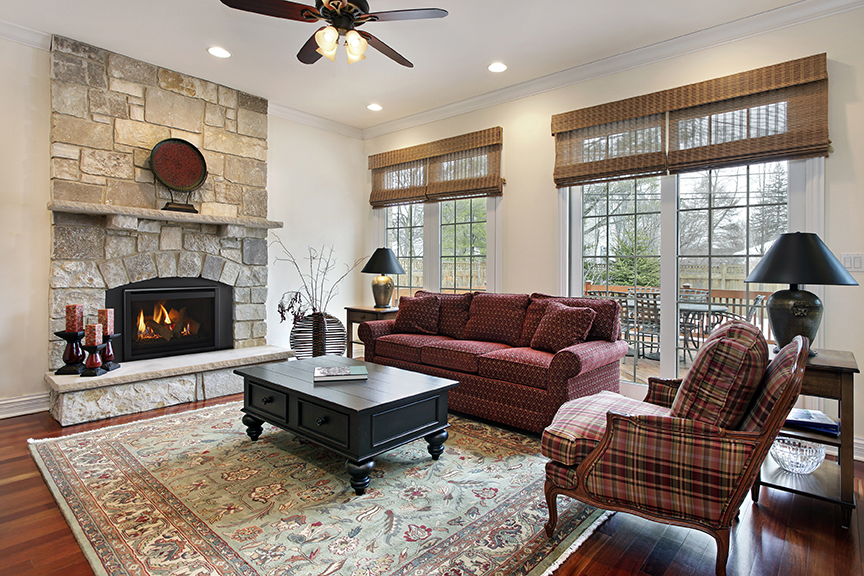
If you are currently experiencing issues with your fireplace but you are not sure if they warrant a complete fireplace replacement, this article is for you!
In this article, we will examine four common problems people run into with their fireplaces. The consist of the pilot light not lighting properly, poor ventilation, damaged glass, and a faulty gas valve. If you are experiencing any of these issues, stop using your fireplace and consider repairing or replacing it as soon as you can.
Click on each corresponding link to jump ahead:
If you are looking to have a new gas fireplace installed, or have your existing fireplace serviced, contact your local Cambridge HVAC technicians at Service 1st Heating and Cooling. When you choose Service 1st, you will receive our professional support and expertise for the entire life of your product.
For even more info on fireplaces, check out our “Guide to Fireplace Maintenance” and our blog post “Should You Buy a Gas Fireplace? Pros and Cons” for more information.
Do You Need a Fireplace Replacement?
1. Pilot Light Not Lighting

A pilot light is what ignites the main burner.
A pilot light is a small, continuously burning flame used to ignite the main burner of a gas appliance. It serves as a source of ignition for the larger burner to start and operate.
Pilot lights are commonly found in older gas appliances. However, newer models often use electronic ignition systems, such as hot surface igniters or spark igniters, which don’t require a continuously burning pilot light. These systems can improve energy efficiency by eliminating the need to keep a flame burning constantly.
A) Troubleshooting the Pilot Light
If your fireplace pilot light is not lighting, there are several steps you can take to troubleshoot and potentially fix the issue before deciding to conduct a fireplace replacement. Here’s a step-by-step guide:
Check Gas Supply
Ensure that the gas supply to the fireplace is turned on. If it’s off, turn it on and attempt to relight the pilot.
Follow Lighting Instructions
Refer to the manufacturer’s instructions for your specific fireplace model. Follow the recommended procedure for lighting the pilot light.
Purge Air From Gas Line
Sometimes, air may enter the gas line, preventing the pilot light from igniting. Hold down the pilot button and purge the air by allowing gas to flow for a few minutes before attempting to light the pilot.
Inspect Thermocouple and Thermopile
Check if the thermocouple and thermopile are clean and positioned correctly. These components are crucial for sensing the presence of the pilot flame. If they are dirty, gently clean them using a soft brush or compressed air.
Look for Obstructions
Inspect the pilot assembly for any debris or blockages that might be preventing the flame from reaching the thermocouple. Clear any obstructions carefully.
Verify Spark Ignition (if applicable)
If your fireplace has a spark ignition system, ensure that the spark electrode is clean and properly positioned.

Here is what a pilot light looks like, a small continuously burning flame.
B) If the Issue Persists
If you’ve gone through the troubleshooting steps and the pilot light still won’t ignite, or if you are uncomfortable performing these tasks, it’s advisable to seek professional help. Here’s what you can do:
Contact the Manufacturer
Consult a Professional Technician
If you are unable to resolve the issue on your own, it’s best to contact a qualified fireplace technician or a licensed HVAC professional. They have the expertise and tools to diagnose and repair more complex issues and educate you on fireplace replacement.
Schedule a Professional Inspection
In some cases, it might be necessary to schedule a professional inspection of your fireplace to identify and address any underlying problems. Regular maintenance by a qualified technician can help prevent issues and ensure the safe operation of your fireplace.
Remember, safety is a top priority when dealing with gas appliances. If you smell gas or suspect a gas leak, immediately turn off the gas supply, ventilate the area, and contact your gas utility provider or emergency services for assistance. Always follow the safety guidelines outlined in your fireplace manual.
2. Poor Ventilation

Make sure your chimney or flue, is in good working order!
Poor ventilation refers to inadequate airflow through the chimney or flue, leading to difficulties in expelling smoke and combustion byproducts. This can result in the accumulation of smoke in the room, reduced efficiency, and potential health hazards.
Indicators that you have poor ventilation are as follows:
- Smoke accumulation
- Difficulty starting or maintaining a fire
- Unpleasant doors
Here’s a breakdown of how to fix, and address the issue if it persists:
A) Fixing Poor Ventilation
Clean the Chimney
Over time, creosote buildup, debris, or blockages can hinder proper ventilation. Regular chimney cleaning is crucial to ensure unrestricted airflow.
Check for Obstructions
Inspect the chimney for any visible obstructions, such as:
- Bird nests
- Creosote buildup
- Leaves
- Debris
Remove any blockages carefully.
Adjust Air Supply
Ensure that there is enough air supply to the room with the fireplace. Inadequate air supply can create negative air pressure, affecting ventilation. Open a window or provide additional sources of ventilation.
Install a Ventilation System
In some cases, installing a ventilation system or using fans strategically can help improve the overall airflow in the room and assist in the venting process.

Your chimney is essential for proper fireplace ventilation!
B) If the Issue Persists
If you’ve gone through these steps and you are still experiencing poor ventilation, or if you are uncomfortable performing these tasks, it’s advisable to seek professional help. Here’s what you can do:
Consult a Professional
If poor ventilation persists despite your efforts, it’s advisable to consult a professional chimney sweep or fireplace technician. They have the expertise to perform a detailed inspection and identify any underlying issues.
Consider Chimney Modifications
A professional may recommend modifications to the chimney or flue to improve ventilation. This could include:
- Changes to the flue size
- Installing a chimney liner
- Making adjustments to the chimney cap
- Conducting a complete fireplace replacement
A professional and local HVAC company will know what to do!
Evaluate Room Ventilation
Assess the overall ventilation in the room. If the room is airtight, it can create negative pressure, affecting the fireplace’s performance. Consult with a heating and ventilation specialist to ensure proper air circulation in the entire space.
Remember, poor ventilation can pose safety risks, including the potential for carbon monoxide buildup. If you’re unable to resolve the issue on your own, seeking professional assistance is crucial to ensure the safe and efficient operation of your fireplace. Regular maintenance and professional inspections are essential for preventing and addressing ventilation problems.
3. Damaged Fireplace Glass

Regularly maintain and clean your fireplace glass to ensure it does not get damaged.
Damaged fireplace glass can be a concern as it not only affects the aesthetics of the fireplace but also poses safety risks. The glass on a fireplace serves as a barrier between the flames and the surrounding environment, preventing sparks, embers, and smoke from entering the room.
To prevent you fireplace glass from being damaged in the first place, do the following:
- Conduct regular maintenance
- Follow manufacturers guidelines
- Avoid using harsh chemicals
Here are some tips for fixing the issue and what to do if the problem persists:
A) How to Fix Damaged Fireplace Glass
Small Chips or Cracks
For minor damage, you can use a fireplace glass repair kit. These kits often include a high-temperature adhesive that can fill in small cracks or chips.
Replacement Glass
If the damage is extensive or compromising the structural integrity of the glass, it’s advisable to replace the entire glass panel. Contact the fireplace manufacturer or a reputable dealer to get the correct fireplace replacement glass.
Professional Repair
In some cases, especially with intricate designs or specialized glass, it might be best to consult a professional fireplace technician or glass specialist. They can assess the damage and recommend the most appropriate solution.

Here is a checklist for a fireplace maintenance inspection.
B) If the Issue Persists
If you’ve gone through these steps and you are still experiencing damaged fireplace glass, or if you are uncomfortable performing these tasks, it’s advisable to seek professional help. Here’s what you can do:
Check the Installation and Ventilation
Ensure that the fireplace is installed correctly and that there are no issues with ventilation. Improper installation or ventilation can contribute to excessive heat, which may be damaging the glass.
Consult the Manufacturer
If the glass continues to exhibit issues, reach out to the fireplace manufacturer for guidance. They can provide specific recommendations and may offer warranty coverage if the damage is due to a manufacturing defect.
Professional Inspection
If you’re unable to identify the root cause of the glass damage, or if the problem persists despite attempts at repair, it’s essential to consult with a professional technician. They can perform a thorough inspection of the fireplace, ensuring that there are no underlying issues affecting the glass.
Remember, damaged fireplace glass not only affects the appearance of the fireplace but also its safety and efficiency. If in doubt or if the damage is extensive, seeking professional assistance is the safest course of action. Regular care and prompt attention to
4. Faulty Gas Valve

If you have a faulty gas valve, the size of your flame may be impacted.
A gas valve is a component that regulates the flow of gas to the burner in a gas fireplace. The gas valve controls the amount of gas released, which in turn affects the size and intensity of the flames.
If the gas valve malfunctions, it can lead to issues such as:
- Difficulty lighting the fireplace
- Uneven flames
- An inability to control the flame size
- Gas odours
- Pilot light won’t stay lit
Here’s an explanation of how to address the issue, and what to do if the problem persists.
A) How to Fix a Faulty Fireplace Gas Valve
Pilot Light Issue
Ensure that the pilot light is clean and positioned correctly. A dirty or misaligned pilot light can affect the proper functioning of the gas valve.
Check Gas Supply
Ensure that there is a steady and sufficient gas supply to the fireplace. If the gas supply is interrupted or inadequate, it can impact the gas valve’s performance.
Thermocouple and Thermopile Inspection
The thermocouple and thermopile are safety devices that sense the presence of a flame. If they are faulty, they may cause the gas valve to shut off. Inspect these components for proper functioning.
Professional Inspection
If you’re not comfortable troubleshooting or if the issue persists, it’s advisable to seek the help of a professional technician or gas fireplace service provider. They can conduct a thorough inspection, identify the specific problem, and recommend the necessary repairs or fireplace replacements.

Ensure your gas valve is working properly and enjoy the peace of mind!
B) If the Issue Persists
If you’ve gone through these steps and you are still dealing with a faulty gas valve, or if you are uncomfortable performing these tasks, it’s advisable to seek professional help. Here’s what you can do:
Gas Valve Replacement
If the gas valve is determined to be faulty, it may need to be replaced. Gas valve replacement is a task best handled by a qualified technician due to the complexity and potential safety risks.
Consult the Manufacturer
Reach out to the fireplace manufacturer for guidance. They can provide information on troubleshooting steps specific to your fireplace model or recommend authorized service providers.
Safety Precautions
If you suspect a gas leak or if there is a strong gas odour, turn off the gas supply to the fireplace immediately, ventilate the area, and contact your gas utility provider or emergency services for assistance.
Remember, working with gas appliances involves safety considerations. If you’re uncertain about how to address a faulty gas valve, it’s crucial to seek professional assistance to ensure the safe and proper functioning of your fireplace. Regular maintenance and prompt attention to any issues can help prevent more significant problems with your gas fireplace.
Need a Fireplace Replacement? Rely on Service 1st, Your Local HVAC Experts


If you are exploring fireplace replacement or maintenance, contact us directly. You can rely on our experience and expertise at Service 1st. When it comes to gas fireplace installation and maintenance, we have you covered. We provide emergency services, maintenance plans, and more!
We have been serving homeowners in Cambridge and the surrounding areas for over 30 years and have a proven record of excellence. Whether it’s time for a simple service call or a furnace replacement, we can help.
We are a locally owned and operated business that prides itself on the highest quality work and installation of the highest quality products. We have received the prestigious Circle of Champions award from Bryant – an honour that highlights our commitment to quality, leadership, and excellence in the HVAC industry. We are an Elite Bryant Factory Authorized Dealer and offer our customers the highest quality products and services.
What Our Customers Are Saying...



“Fireplace yearly maintenance/tune-up. Corey was able to come earlier than scheduled. Fireplace was installed just over a year ago; looks brand new again. All technicians over the years have been on time, professional, efficient, knowledgeable (answer any and all questions) and friendly – almost like family, will continue to use Service 1st.”
Debbie, M.




